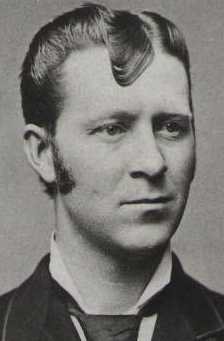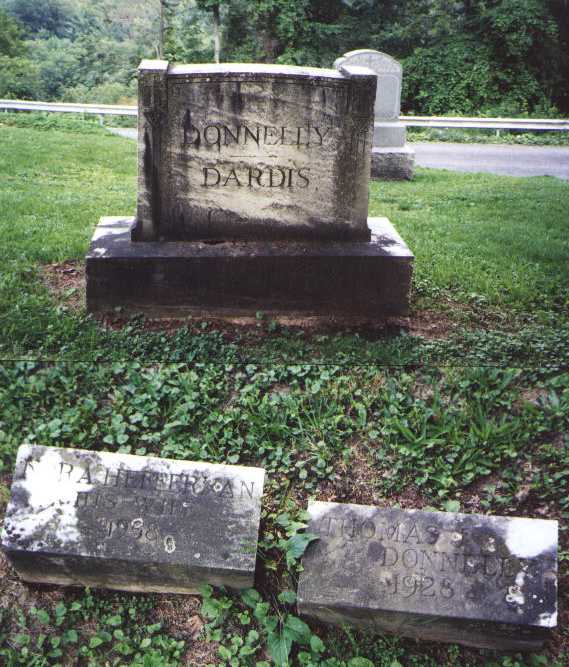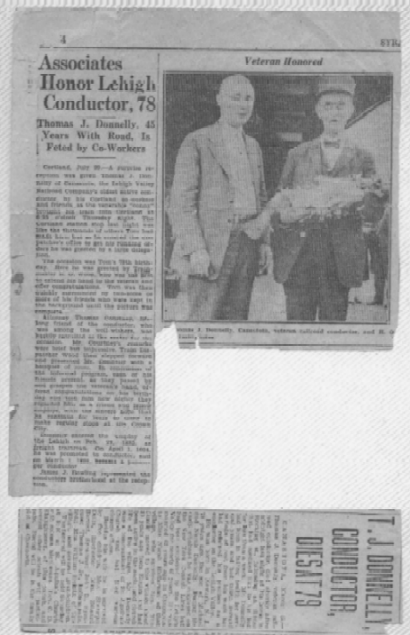By 1855 Thomas was the foster child of John and Mary Dardis, a childless couple from Ireland, and they were living in Cazenovia, Madison County, New York. Mary Winn Dardis was his aunt (his mother's sister). By 1860 Thomas and the Dardis family had moved to the Spencer Township area of Jennings County, Indiana where they farmed. Later (between 1870 and 1875), John and Mary Dardis and Thomas re-joined the rest of the Dardis family in Madison County, New York.
A family tradition (as told by his grandson Thomas M. Donnelly) says that somehow Thomas lost contact with his birth mother. Two years after Michael's death, she married Elisha Williams of Newark and had more children. Thomas had at least three younger half-siblings of whom he may not have been aware.
At age 32 Thomas married Honora "Nora" Heffernan Donnelly from Tipperary, Ireland on October 18, 1881 in Cazenovia, Madison County, and they had seven children: Helen M. Donnelly Dietz, Mary Lillian Donnelly Barrett, Nora Donnelly, Catherine Donnelly, John Dardis Donnelly, Thomas James Donnelly, and Dorothy Donnelly Heintz. The family lived in Canastota, Madison County.
Upon the death of Thomas' brother James, the Canadian Government sent a "Report of Death of an American Citizen" to his brother, Thomas John Donnelly, in Canastota, Madison County, New York. (Thomas then lived at 108 Stocking Street in Canastota.) Even though brothers James and Thomas were separated as young children, that death report is proof either of their efforts to remain in touch or to reestablish contact. It is a testimony to the power of family.
In Indiana Thomas had farmed with his foster parents John and Mary Dardis. For most of his life, however, Thomas John Donnelly was a railroad conductor first for the New York Central Lines Railroad and then the Lehigh Valley Railroad. Thomas began work with the Lehigh Valley system February 28, 1882, as a trainman. On April 1, 1884 he was promoted to be a conductor and March 1, 1895 a passenger conductor, a position he held until his death. He died on March 14, 1928 in Madison County at age 78 after years of failing health.
His funeral Mass was at Saint Agatha Roman Catholic Church in Canastota. His nephews were pall bearers. He is buried in Saint James Catholic Cemetery in Cazenovia. Officials and employees of the Lehigh Valley railroad gave him a tribute seldom, if ever before, accorded a Canastota citizen when they went there on a special train to attend the services. Every station on the Lehigh between Canastota and Cortland is said to have been represented among the party of railroad men.
Thomas had an extensive legacy of namesakes. The first Thomas Donnelly had one son, three grandsons, one great-grandson, two great-great-grandsons, and one great-great-great-grandson, all named Thomas Donnelly.
DNA tests on his direct-line male descendants reveal him to be a Celt descended from the Irish clan of Ui Neill who claimed the Irish High Kingship from 600 to 1000 AD. Niall of the Nine Hostages was one of the most prominent descendant of Conn of the Hundred Battles who was the first high king of Ireland. On one of Niall's raids into Britain, a child later to become Saint Patrick was abducted. The four treasures of Ireland were the Lia Fail (the Stone of Destiny), the Spear Luin (the Spear of Direction), the Claiomh Solais (the Sword of Truth), and the Coire Anseasc (the Cauldron of Prosperity). The Stone of Destiny would cry out when a true King of Ireland stood on it. Conn of the Hundred Battles found the Stone of Destiny. The Spear of Direction was renowned for accuracy, and no one carrying it ever lost a battle. No one ever escaped from the Sword of Truth once it was pulled from its sheath. The Cauldron of Prosperity was bottomless, capable of feeding an army.
DNA testing also reveals Thomas Donnelly and his direct male descendents are of the patrilineal clan of "Oisin" (pronounced "O-sheen") (Y-chromosome clade R1b). Oisin lived about 40,000 years ago in the Celtic area of Western Europe. Oisin was one of about seventeen men alive at that time from whom all people alive today are descended.
The Donnelly family crest that has been passed down for centuries among Michael Donnelly's ancestors and descendants shows three silver lilies (fleurs-de-lis) on a shield of black with the Latin motto, "Fortiter et Fideliter," or, in English, "Courageously and Faithfully." The black of the shield symbolizes constancy and faithfulness, and the silver of the lilies represents peace and sincerity. The fleur-de-lis symbols represent the Virgin Mary and the Irish Donnellys' sympathies with the Catholic rulers of France and Scotland. So, in addition to representing the Christian Trinity, the three lilies may represent the Catholic Celts of Ireland, Scotland, and France. In the Gaelic language of Ireland, "Donnelly" means "Dark Courage."
Thanks so much to all the Donnelly and Heffernan family genealogists for much of this information. Any errors, however, are mine alone. Please go to the "edit" link on this site with any corrections or additions.
By 1855 Thomas was the foster child of John and Mary Dardis, a childless couple from Ireland, and they were living in Cazenovia, Madison County, New York. Mary Winn Dardis was his aunt (his mother's sister). By 1860 Thomas and the Dardis family had moved to the Spencer Township area of Jennings County, Indiana where they farmed. Later (between 1870 and 1875), John and Mary Dardis and Thomas re-joined the rest of the Dardis family in Madison County, New York.
A family tradition (as told by his grandson Thomas M. Donnelly) says that somehow Thomas lost contact with his birth mother. Two years after Michael's death, she married Elisha Williams of Newark and had more children. Thomas had at least three younger half-siblings of whom he may not have been aware.
At age 32 Thomas married Honora "Nora" Heffernan Donnelly from Tipperary, Ireland on October 18, 1881 in Cazenovia, Madison County, and they had seven children: Helen M. Donnelly Dietz, Mary Lillian Donnelly Barrett, Nora Donnelly, Catherine Donnelly, John Dardis Donnelly, Thomas James Donnelly, and Dorothy Donnelly Heintz. The family lived in Canastota, Madison County.
Upon the death of Thomas' brother James, the Canadian Government sent a "Report of Death of an American Citizen" to his brother, Thomas John Donnelly, in Canastota, Madison County, New York. (Thomas then lived at 108 Stocking Street in Canastota.) Even though brothers James and Thomas were separated as young children, that death report is proof either of their efforts to remain in touch or to reestablish contact. It is a testimony to the power of family.
In Indiana Thomas had farmed with his foster parents John and Mary Dardis. For most of his life, however, Thomas John Donnelly was a railroad conductor first for the New York Central Lines Railroad and then the Lehigh Valley Railroad. Thomas began work with the Lehigh Valley system February 28, 1882, as a trainman. On April 1, 1884 he was promoted to be a conductor and March 1, 1895 a passenger conductor, a position he held until his death. He died on March 14, 1928 in Madison County at age 78 after years of failing health.
His funeral Mass was at Saint Agatha Roman Catholic Church in Canastota. His nephews were pall bearers. He is buried in Saint James Catholic Cemetery in Cazenovia. Officials and employees of the Lehigh Valley railroad gave him a tribute seldom, if ever before, accorded a Canastota citizen when they went there on a special train to attend the services. Every station on the Lehigh between Canastota and Cortland is said to have been represented among the party of railroad men.
Thomas had an extensive legacy of namesakes. The first Thomas Donnelly had one son, three grandsons, one great-grandson, two great-great-grandsons, and one great-great-great-grandson, all named Thomas Donnelly.
DNA tests on his direct-line male descendants reveal him to be a Celt descended from the Irish clan of Ui Neill who claimed the Irish High Kingship from 600 to 1000 AD. Niall of the Nine Hostages was one of the most prominent descendant of Conn of the Hundred Battles who was the first high king of Ireland. On one of Niall's raids into Britain, a child later to become Saint Patrick was abducted. The four treasures of Ireland were the Lia Fail (the Stone of Destiny), the Spear Luin (the Spear of Direction), the Claiomh Solais (the Sword of Truth), and the Coire Anseasc (the Cauldron of Prosperity). The Stone of Destiny would cry out when a true King of Ireland stood on it. Conn of the Hundred Battles found the Stone of Destiny. The Spear of Direction was renowned for accuracy, and no one carrying it ever lost a battle. No one ever escaped from the Sword of Truth once it was pulled from its sheath. The Cauldron of Prosperity was bottomless, capable of feeding an army.
DNA testing also reveals Thomas Donnelly and his direct male descendents are of the patrilineal clan of "Oisin" (pronounced "O-sheen") (Y-chromosome clade R1b). Oisin lived about 40,000 years ago in the Celtic area of Western Europe. Oisin was one of about seventeen men alive at that time from whom all people alive today are descended.
The Donnelly family crest that has been passed down for centuries among Michael Donnelly's ancestors and descendants shows three silver lilies (fleurs-de-lis) on a shield of black with the Latin motto, "Fortiter et Fideliter," or, in English, "Courageously and Faithfully." The black of the shield symbolizes constancy and faithfulness, and the silver of the lilies represents peace and sincerity. The fleur-de-lis symbols represent the Virgin Mary and the Irish Donnellys' sympathies with the Catholic rulers of France and Scotland. So, in addition to representing the Christian Trinity, the three lilies may represent the Catholic Celts of Ireland, Scotland, and France. In the Gaelic language of Ireland, "Donnelly" means "Dark Courage."
Thanks so much to all the Donnelly and Heffernan family genealogists for much of this information. Any errors, however, are mine alone. Please go to the "edit" link on this site with any corrections or additions.



















